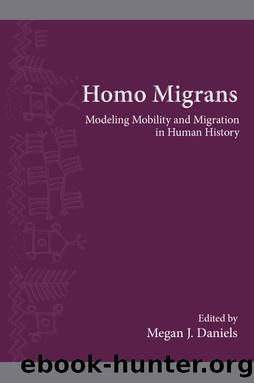Homo Migrans by Megan J. Daniels;

Author:Megan J. Daniels;
Language: eng
Format: epub
Publisher: State University of New York Press
Published: 2022-08-15T00:00:00+00:00
The next two sections examine the implementation and implications of this modified CDM for the dispersal of early farming across the western Balkans, and especially the Adriatic basin. After verifying that the assumptions behind the computational model are warranted by archaeological data, we then test the three aforementioned predictions briefly against the extensive and high-resolution zooarchaeological record.
TESTING ASSUMPTIONS
The demographic variant of the CDM presented here rests upon three main assumptions: (1) the importance of homophily as an evolutionary force; (2) the existence of a demographically driven wave of expansion during the period under consideration; (3) an emptyâor at least comparatively lowly populatedâlandscape within which the wave advances.
The first assumption rests upon a purely theoretical point regarding the general relevance of homophily for human evolutionary history, as it governs the interaction and exchange of traits between agents within the framework of the CDM. While archaeological computational approaches to cultural transmission, especially under the influence of evolutionary thought, have devoted much energy to identifying and quantifying biased transmission (see review in Lake 2014), comparatively limited attention has been paid to specific forms of biased transmission such as homophily (e.g., Shennan et al. 2014; Madsen and Lipo 2015). This theoretical gap is, however, damageable as an extensive sociological and evolutionary literature demonstrates the key role of homophily in structuring social networks (see reviews in McPherson et al. 2001; Haun and Over 2013).
The second assumption rests upon the existence of a demic wave of expansion in the chosen research area in the corresponding period. Testing this assumption requires the ability to directly identify a process of expansion and to link it to a regime shift in the demography of the corresponding human populations. In both cases, the 14C record provides the necessary data. Although, at a local scale, the history of research in the area prevents systematic in-depth analysis, the dataset meets all minimum quantitative criteria for exploratory data analysis at a macro scale (see Williams 2012). Figure 9.3 provides an interpolation of the oldest 14C dates associated with the local introduction of plant and animal domesticates. The chosen geostatistical technique is an ordinary kriging, undertaken in the R statistical environment (R core team 2018) using the gstat (for spatial statistics: Gräler et al. 2016) and tmap (for thematic mapping; Tennekes 2018) packages. This figure shows a clear SE-NW gradientâi.e., aligned with the main axis of the Adriatic Seaâin the dispersal of domesticates, as well as a relative pause between a major expansion at the turn of the ninth and eighth millennia cal B.P. then resuming toward 7600â7500 cal B.P. to encompass the entire northern part of the Adriatic basin (see also Silva and Vander Linden 2017). The radiocarbon record can also be used to evaluate if this dispersal is associated with a change of demographic regime. Figure 9.4 shows temporal variations of the demographic growth rate, calculated using the function spd2rc in the R package rcarbon (Bevan and Crema 2018), for the period between 9000 and 7000 cal B.P. in the Adriatic basin, expressed on the left as an annual growth rate and, on the right, in relative percentage.
Download
This site does not store any files on its server. We only index and link to content provided by other sites. Please contact the content providers to delete copyright contents if any and email us, we'll remove relevant links or contents immediately.
Chaco's Northern Prodigies : Salmon, Aztec, and the Ascendancy of the Middle San Juan Region after AD 1100 by Paul F. Reed(355)
Law Enforcement Interpersonal Communication and Conflict Management by Brian Douglas Fitch(347)
Digital International Relations by Unknown(347)
Critical Perspectives on Human Security : Rethinking Emancipation and Power in International Relations by David Chandler; Nik Hynek(329)
Skilled interpersonal communication: Research, theory and practice, Fifth edition by Owen Hargie(327)
The Enduring Color Line in U.S. Athletics by Krystal Beamon Chris M. Messer(325)
Evidence-Based Policy Making in Labor Economics by Hamermesh Daniel S.;Nottmeyer Olga K.;Nottmeyer Olga;King Sarah;King Sarah;King Sarah;(298)
EPSO CAST Political affairs EU policies: How to succeed in the selection procedure by Franco Reverte José María(290)
Writing Public Policy - A Practical Guide to Communicating in the Policy Making Process by Catherine F. Smith(272)
Criminological Theory in Context by John Martyn Chamberlain(270)
Tibeton Yoga Its Secret Doc by Evans-Wentz(267)
Threshold Concepts in Women's and Gender Studies by Christie Launius Holly Hassel(264)
Rothschild and Early Jewish Colonization in Palestine (Geographical Perspectives on the Human Past) by Ran Aaronsohn(264)
Positive Psychology and Spirituality in Counselling and Psychotherapy (Conflict, Ethics, and Spirituality, 12) by unknow(261)
Social Problems, Social Issues, Social Science by James Wright(260)
Play in child development and psychotherapy: toward empirically supported practice by Sandra W. Russ(254)
Cognitive Development in Infancy and Childhood (Elements in Child Development) by Mary Gauvain(252)
Latin American Politics and Society by Gerardo L. Munck & Juan Pablo Luna(224)
What Makes a Social Crisis?: The Societalization of Social Problems by Jeffrey C. Alexander(220)
